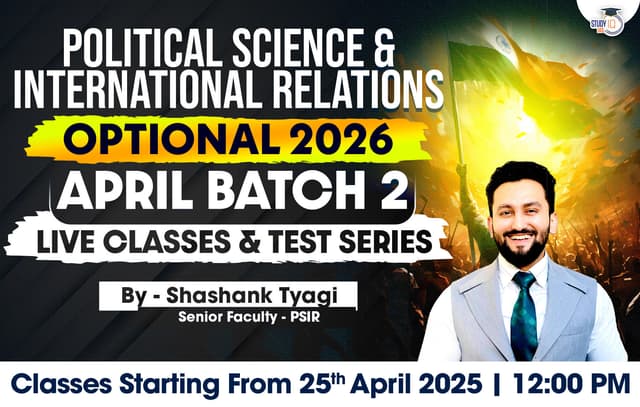Daily Quiz 29 April 2025
Quiz-summary
0 of 5 questions completed
Questions:
- 1
- 2
- 3
- 4
- 5
Information
- Click on – ‘Start Quiz’ button
- Solve Questions
- Click on ‘Next’ button
- Click on ‘Finish Quiz’ button
- Now click on ‘View Questions’ button – here you will see solutions and links.
- The test contains a total of 5 questions.
- Click on the most appropriate option to mark it as your answer.
- You will be awarded Two marks for each correct answer.
- You can change your answer by clicking on some other option.
- A Number list of all questions appears at the top side of the screen.
- You can access the questions in any order by clicking on the question number given on the number list.
- You can use rough sheets while taking the test.
- Do not use calculators, log tables, dictionaries, or any other printed/online reference material during the test.
- Do not click the button “Finish Quiz” before completing the test. A test once submitted cannot be resumed.
You have already completed the quiz before. Hence you can not start it again.
Quiz is loading...
You must sign in or sign up to start the quiz.
You have to finish following quiz, to start this quiz:
- 1
- 2
- 3
- 4
- 5
- Answered
- Review
-
Question 1 of 5
1. Question
1 pointsConsider the following statements regarding the Countercyclical Capital Buffer (CCyB) under Basel III norms:
- Its primary objective is to protect the banking sector from periods of excess aggregate credit growth.
- It is implemented as an extension of the capital conservation buffer and consists entirely of Common Equity Tier 1 capital.
- If the minimum CCyB requirement is breached, restrictions are imposed on the bank’s operations and lending activities.
How many of the above statements are correct?
Correct
Answer: B
Explanation:
- The countercyclical capital buffer aims to ensure that banking sector capital requirements take account of the macro-financial environment in which banks operate. Its primary objective is to use a buffer of capital to achieve the broader macroprudential goal of protecting the banking sector from periods of excess aggregate credit growth that have often been associated with the build-up of system-wide risk. Due to its countercyclical nature, the countercyclical capital buffer regime may also help to lean against the build-up phase of the credit cycle in the first place. In downturns, the regime should help to reduce the risk that the supply of credit will be constrained by regulatory capital requirements that could undermine the performance of the real economy and result in additional credit losses in the banking system.
- Statement 1 is correct – The CCyB aims to protect the banking sector during periods of excess credit growth, which can build up systemic risk.
- Statement 2 is correct – It is an extension of the capital conservation buffer and consists entirely of Common Equity Tier 1 capital.
Statement 3 is incorrect – If the buffer is breached, only capital distribution constraints (like restrictions on dividend payments, share buybacks, etc.) are imposed, not operational or lending restrictions.
Incorrect
Answer: B
Explanation:
- The countercyclical capital buffer aims to ensure that banking sector capital requirements take account of the macro-financial environment in which banks operate. Its primary objective is to use a buffer of capital to achieve the broader macroprudential goal of protecting the banking sector from periods of excess aggregate credit growth that have often been associated with the build-up of system-wide risk. Due to its countercyclical nature, the countercyclical capital buffer regime may also help to lean against the build-up phase of the credit cycle in the first place. In downturns, the regime should help to reduce the risk that the supply of credit will be constrained by regulatory capital requirements that could undermine the performance of the real economy and result in additional credit losses in the banking system.
- Statement 1 is correct – The CCyB aims to protect the banking sector during periods of excess credit growth, which can build up systemic risk.
- Statement 2 is correct – It is an extension of the capital conservation buffer and consists entirely of Common Equity Tier 1 capital.
Statement 3 is incorrect – If the buffer is breached, only capital distribution constraints (like restrictions on dividend payments, share buybacks, etc.) are imposed, not operational or lending restrictions.
-
Question 2 of 5
2. Question
1 pointsWith reference to Tensor Processing Units (TPUs), consider the following statements:
- TPUs are application-specific integrated circuits designed primarily for accelerating machine learning tasks.
- Unlike Central Processing Units (CPUs) and Graphics Processing Units (GPUs), TPUs are general-purpose processors that can perform a wide variety of computing tasks efficiently.
- TPUs are engineered to handle tensor operations and enable faster training of artificial intelligence (AI) models.
How many of the above statements are correct?
Correct
Answer: B
Explanation:
- Processing units are essentially hardware units that are the brain of a computer. Like the human brain handles tasks such as reading and solving a math problem, processing units also perform tasks. These could be doing calculations, taking a picture, or sending a text.
- Statement 1 is correct – TPUs are indeed a type of Application-Specific Integrated Circuit (ASIC), built specifically to accelerate machine learning tasks. TPUs are engineered to handle tensor — a generic name for the data structures used for machine learning — operations. They excel in processing large volumes of data and executing complex neural networks efficiently, enabling fast training of AI models. While AI models can take weeks to be trained with the help of GPUs, the same process can be executed within hours using TPUs.
- Statement 2 is incorrect – TPUs are not general-purpose processors. They are highly specialized for AI tasks, unlike Central Processing Units (CPUs) (general-purpose) and Graphics Processing Units (GPUs) (flexible, but broader than TPUs).
Statement 3 is correct – TPUs handle tensor operations and enable faster training of AI models compared to GPUs.
Incorrect
Answer: B
Explanation:
- Processing units are essentially hardware units that are the brain of a computer. Like the human brain handles tasks such as reading and solving a math problem, processing units also perform tasks. These could be doing calculations, taking a picture, or sending a text.
- Statement 1 is correct – TPUs are indeed a type of Application-Specific Integrated Circuit (ASIC), built specifically to accelerate machine learning tasks. TPUs are engineered to handle tensor — a generic name for the data structures used for machine learning — operations. They excel in processing large volumes of data and executing complex neural networks efficiently, enabling fast training of AI models. While AI models can take weeks to be trained with the help of GPUs, the same process can be executed within hours using TPUs.
- Statement 2 is incorrect – TPUs are not general-purpose processors. They are highly specialized for AI tasks, unlike Central Processing Units (CPUs) (general-purpose) and Graphics Processing Units (GPUs) (flexible, but broader than TPUs).
Statement 3 is correct – TPUs handle tensor operations and enable faster training of AI models compared to GPUs.
-
Question 3 of 5
3. Question
1 pointsConsider the following statements with reference to lions:
- The IUCN Green Status assessment for lions ranks them as ‘Largely Depleted’.
- Lions are listed as Critically Endangered on the IUCN Red List of Threatened Species.
Which of the above statements is/are correct?
Correct
Answer: A
Explanation:
- Statement 1 is correct and statement 2 is not correct: The International Union for Conservation of Nature (IUCN) has come out with its first Green Status assessment for the lion (Panthera leo).
The first Green Status assessment for the lion (Panthera leo) shows that it is Largely Depleted, while the species remains Vulnerable on the IUCN Red List. Today’s Green Status assessment shows that human impacts are preventing the lion from being fully ecologically functional across its range, as the species declines across large areas and is extinct from North Africa and Southwest Asia.
Incorrect
Answer: A
Explanation:
- Statement 1 is correct and statement 2 is not correct: The International Union for Conservation of Nature (IUCN) has come out with its first Green Status assessment for the lion (Panthera leo).
The first Green Status assessment for the lion (Panthera leo) shows that it is Largely Depleted, while the species remains Vulnerable on the IUCN Red List. Today’s Green Status assessment shows that human impacts are preventing the lion from being fully ecologically functional across its range, as the species declines across large areas and is extinct from North Africa and Southwest Asia.
-
Question 4 of 5
4. Question
1 pointsWhat is QpiAI-Indus, recently seen in the news?
Correct
Answer: C
Explanation:
- Option C is correct: QpiAI-Indus, the quantum computer launched, is the first full-stack quantum computing system in the country and combines advanced quantum hardware, scalable control, and optimized software for transformative hybrid computing. It integrates advanced quantum processors, next-generation Quantum-HPC software platforms, and AI-enhanced quantum solutions.
As a part of India’s National Quantum Mission, QpiAI is at the forefront of building the country’s quantum computing technology ecosystem, national quantum adoption programs, and creating one of the world’s largest quantum talent ecosystems. QpiAI is committed to accelerating India’s quantum journey, making quantum computing technologies practical, accessible, and globally impactful. The technologies from the company, bootstrapped in 2019, have led to 11 patent applications and generated a revenue of around Rs 1 million per annum. They have also generated substantial capital from the Small Industries Development Bank of India (SIDBI).
Incorrect
Answer: C
Explanation:
- Option C is correct: QpiAI-Indus, the quantum computer launched, is the first full-stack quantum computing system in the country and combines advanced quantum hardware, scalable control, and optimized software for transformative hybrid computing. It integrates advanced quantum processors, next-generation Quantum-HPC software platforms, and AI-enhanced quantum solutions.
As a part of India’s National Quantum Mission, QpiAI is at the forefront of building the country’s quantum computing technology ecosystem, national quantum adoption programs, and creating one of the world’s largest quantum talent ecosystems. QpiAI is committed to accelerating India’s quantum journey, making quantum computing technologies practical, accessible, and globally impactful. The technologies from the company, bootstrapped in 2019, have led to 11 patent applications and generated a revenue of around Rs 1 million per annum. They have also generated substantial capital from the Small Industries Development Bank of India (SIDBI).
-
Question 5 of 5
5. Question
1 pointsConsider the following statements:
- The collision of the Indian plate with the Eurasian plate (including Asian plate) led to the formation of the Himalaya and upliftment of the Tibetan plateau.
- Cona-Sangri Rift is a fracture in the Tibetean plateau.
Which of the above statements is/are correct?
Correct
Answer: C
Explanation:
- The Indian plate is a major tectonic plate straddling the equator in the Northeast Hemisphere. It is bordered by four major plates. The Eurasian (consisting of Europe and Asia) plate lies to the north, the Arabian plate to the west, the African plate including Somali to the south west and the Australian plate to the south east. The minor Burma plate lies to the east
- Statement 1 is correct: The collision of the Indian plate with the Eurasian plate (including Asian plate) led to the formation of the Himalaya and upliftment of the Tibetan plateau. It is noted that India-Asia collision is not a single tectonic event, but it happened in a phased manner.
Statement 2 is correct: A deep fracture in the Tibetan Plateau known as the Cona-Sangri rift overlies the tear.
Incorrect
Answer: C
Explanation:
- The Indian plate is a major tectonic plate straddling the equator in the Northeast Hemisphere. It is bordered by four major plates. The Eurasian (consisting of Europe and Asia) plate lies to the north, the Arabian plate to the west, the African plate including Somali to the south west and the Australian plate to the south east. The minor Burma plate lies to the east
- Statement 1 is correct: The collision of the Indian plate with the Eurasian plate (including Asian plate) led to the formation of the Himalaya and upliftment of the Tibetan plateau. It is noted that India-Asia collision is not a single tectonic event, but it happened in a phased manner.
Statement 2 is correct: A deep fracture in the Tibetan Plateau known as the Cona-Sangri rift overlies the tear.
Results
0 of 5 questions answered correctly
Your time:
Time has elapsed
You have reached 0 of 0 points, (0)
| Average score |
|
| Your score |
|
Categories
- Not categorized 0%
| Pos. | Name | Entered on | Points | Result |
|---|---|---|---|---|
| Table is loading | ||||
| No data available | ||||
Sharing is caring!


 Daily Quiz 26 April 2025
Daily Quiz 26 April 2025





















